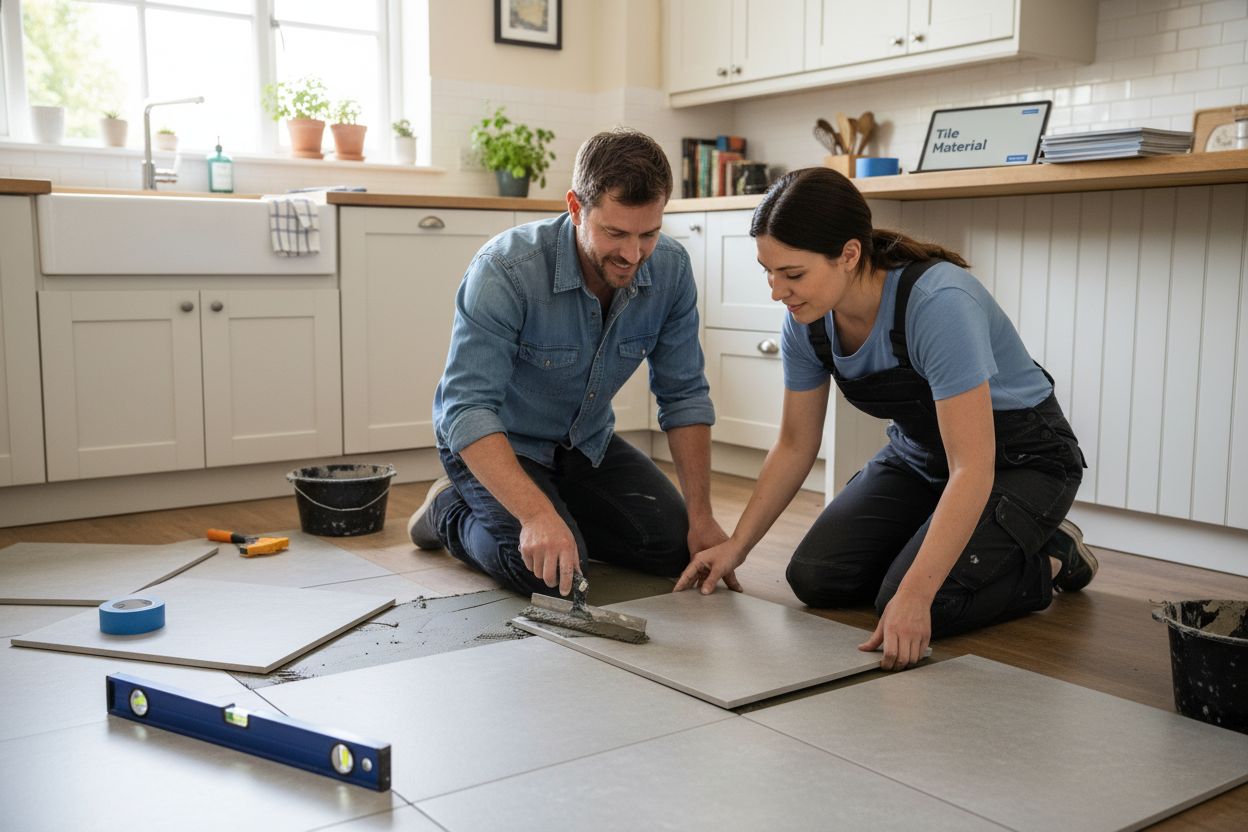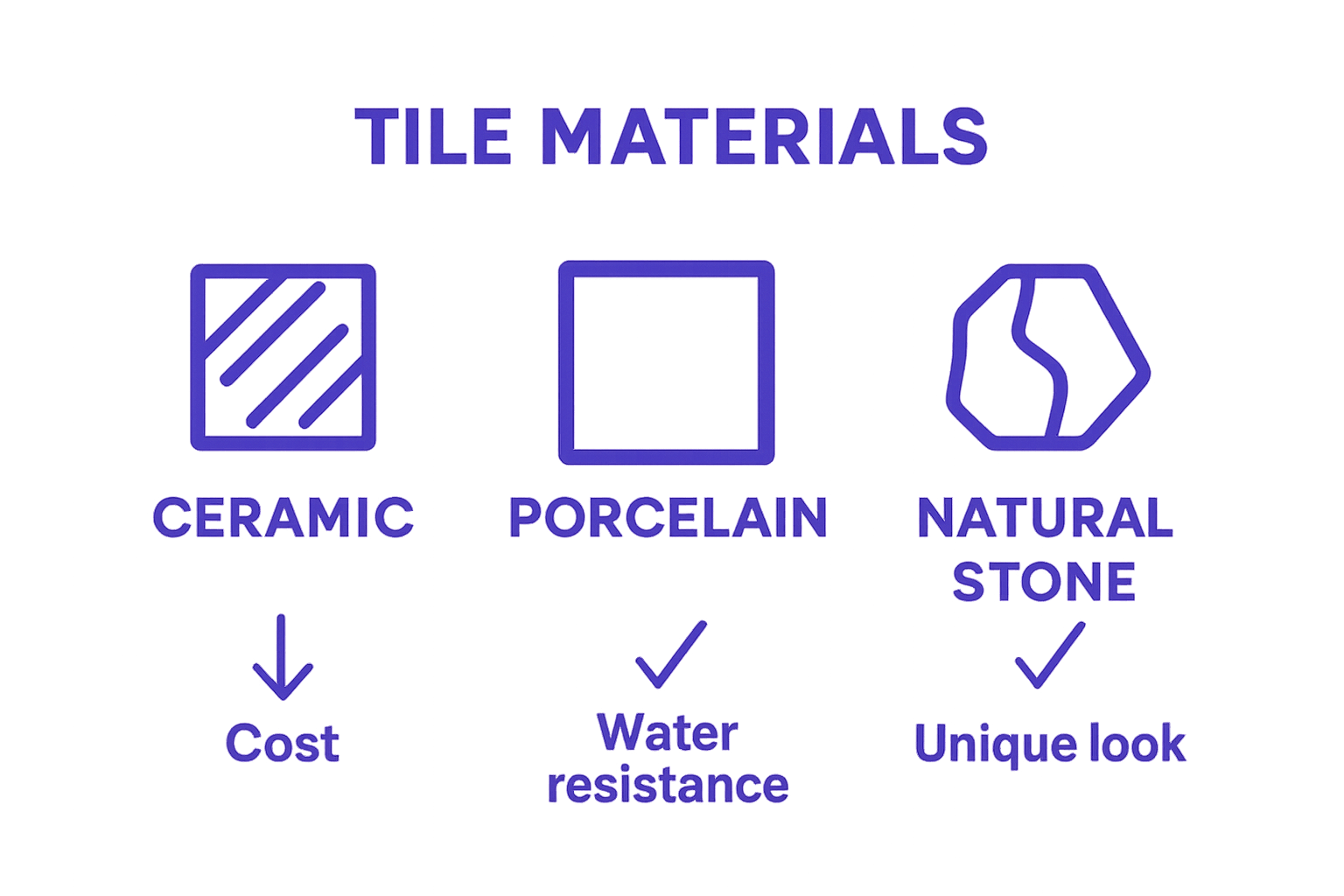Understanding the Role of Tiles in Kitchen Design
Posted by Mike Belk on Oct 03, 2025

Tiles shape the atmosphere of every kitchen and offer more than just a pretty surface. Kitchens with tile floors or backsplashes can last decades longer because properly installed tiles can extend the lifespan of kitchen surfaces by years. Most people think tiles are just for looks or easy cleaning but they actually transform an ordinary kitchen into a space that seamlessly blends protection, style, and safety all at once.
Table of Contents
- What Are Tiles And Their Purpose In Kitchen Design
- Why Tiles Matter: Aesthetic, Practical, And Safety Aspects
- How Different Tile Materials Affect Kitchen Functionality
- Exploring Tile Placement: Patterns, Layouts, And Visual Impact
- Real-World Examples: Successful Kitchen Designs With Tiles
Quick Summary
| Takeaway | Explanation |
|---|---|
| Tiles enhance kitchen function and aesthetics | Tiles provide durable protection and visual appeal to kitchen surfaces, making them essential in design. |
| Material choice impacts kitchen performance | Different tile materials, like ceramic and porcelain, offer unique benefits affecting durability and maintenance. |
| Strategic tile layout alters spatial perception | Tile arrangement can visually expand or contract spaces, influence movement, and create focal points in the kitchen. |
| Textured tiles improve safety | Textured surfaces reduce slip risks, while non-porous tiles prevent bacteria, enhancing hygiene and safety in kitchens. |
| Innovative tile designs create impact | Modern designs utilize bold patterns and materials, transforming kitchens into personalized and visually striking environments. |
What Are Tiles and Their Purpose in Kitchen Design
Tiles are versatile surface materials that play a critical role in kitchen design, offering both functional protection and aesthetic enhancement. According to architectural research, tiles have been fundamental in kitchen environments for centuries, providing durable, hygienic surfaces that withstand daily wear and demanding conditions.
The Fundamental Characteristics of Kitchen Tiles
At their core, tiles are manufactured materials typically made from ceramic, porcelain, natural stone, or glass, designed to create smooth, seamless surfaces that can cover walls, floors, and countertops. Their primary attributes include:
- High durability and resistance to moisture
- Easy to clean and maintain
- Capable of withstanding temperature variations
- Available in diverse designs, colors, and textures
These characteristics make tiles an exceptional choice for kitchen spaces, where surfaces must endure frequent cleaning, potential spills, heat exposure, and constant foot traffic. Research indicates that properly installed tiles can significantly extend the functional lifespan of kitchen surfaces.
Functional and Aesthetic Roles in Kitchen Design
Tiles serve dual purposes in kitchen environments. Functionally, they protect underlying surfaces from moisture, stains, and physical damage. Aesthetically, they introduce visual interest, color, and personality to the space. Homeowners can read more about bold kitchen tile design strategies to transform their kitchen’s visual appeal.
Whether used as backsplashes, flooring, or wall cladding, tiles offer homeowners unprecedented design flexibility. They can create focal points, establish design themes, and complement overall kitchen aesthetics while providing critical protective functions. Their adaptability makes them an indispensable element in modern kitchen design, bridging the gap between practical necessity and artistic expression.
Why Tiles Matter: Aesthetic, Practical, and Safety Aspects
Tiles are far more than simple decorative elements in kitchen design. They represent a complex intersection of form, function, and safety, delivering multifaceted benefits that extend well beyond surface appearance. Building design experts emphasize the critical role materials play in creating environments that are both beautiful and resilient.
The Aesthetic Dimensions of Kitchen Tiles
Visual impact remains a primary consideration when selecting kitchen tiles. They serve as design elements that can dramatically transform a space, offering:
- Color coordination and visual harmony
- Opportunities for personal expression
- Ability to create focal points and visual interest
- Capacity to complement or contrast existing design elements
From minimalist monochromatic designs to intricate mosaic patterns, tiles provide homeowners unprecedented creative freedom in defining their kitchen’s visual narrative. Explore bold kitchen tile design strategies to understand how strategic tile selection can revolutionize kitchen aesthetics.
Practical and Safety Considerations
Beyond aesthetics, tiles deliver crucial practical advantages that make them indispensable in kitchen environments. Their engineered composition provides robust protection against moisture, heat, and mechanical stress. Scientific research demonstrates that properly selected and installed tiles can significantly enhance kitchen surface durability and hygiene.
Safety emerges as another critical aspect of tile selection. Textured surfaces can minimize slip risks, while non-porous materials prevent bacterial growth and simplify cleaning. Tiles act as a protective barrier, shielding underlying structures from potential damage caused by spills, temperature fluctuations, and daily wear.
Ultimately, tiles represent a sophisticated solution that harmonizes aesthetic preferences with practical requirements, transforming kitchens into spaces that are simultaneously beautiful, functional, and safe.
How Different Tile Materials Affect Kitchen Functionality
The performance of kitchen tiles hinges critically on their material composition, with each type offering unique characteristics that influence durability, maintenance, and aesthetic appeal. Material science research reveals that the selection of tile material can dramatically impact a kitchen’s long-term functionality and design potential.
Ceramic and Porcelain Tiles: The Standard Bearers
Ceramic and porcelain tiles represent the most common materials in kitchen design, each presenting distinctive advantages. Ceramic tiles are crafted from clay and fired at lower temperatures, making them:
- More affordable
- Lighter in weight
- Available in extensive color ranges
- Suitable for moderate traffic areas
Porcelain tiles, a more refined subset of ceramic, undergo higher-temperature firing, resulting in superior density and lower water absorption. Learn more about kitchen flooring tile options to understand how material selection impacts overall kitchen performance.
Natural Stone and Specialty Tiles: Advanced Performance Characteristics
Natural stone tiles like granite, marble, and slate introduce exceptional durability and unique aesthetic qualities. These materials offer:
- Exceptional heat resistance
- Natural variation in color and texture
- High-end visual appeal
- Superior longevity when properly maintained
Specialty tiles such as glass and metal provide additional design flexibility, allowing homeowners to create distinctive visual statements while maintaining functional integrity. Each material brings specific thermal, moisture-resistance, and aesthetic properties that can transform kitchen spaces.
Below is a comparison table outlining the core characteristics, benefits, and ideal uses of common kitchen tile materials discussed in the article.
| Tile Material | Key Characteristics | Benefits | Ideal Use Cases |
|---|---|---|---|
| Ceramic | Fired at lower temperatures, less dense | Affordable, lightweight, diverse colors | Backsplashes, wall tiles |
| Porcelain | Fired at higher temperatures, highly dense, low absorption | Very durable, low water absorption, versatile | Floors, high-traffic areas |
| Natural Stone | Unique color/texture variation, natural material | Heat-resistant, luxurious look, long-lasting | Countertops, floors |
| Glass | Non-porous, reflective, vibrant colors | Easy to clean, modern aesthetics, resists stains | Backsplashes, accents |
| Metal | Durable, industrial look | Modern design, heat resistant | Backsplashes, accents |

Understanding the nuanced characteristics of different tile materials empowers homeowners to make informed decisions that balance visual preferences with practical performance requirements, ensuring their kitchen remains both beautiful and functional for years to come.

Exploring Tile Placement: Patterns, Layouts, and Visual Impact
Tile placement transcends mere surface coverage, representing a sophisticated design strategy that dramatically transforms kitchen aesthetics and spatial perception. Architectural design experts emphasize that strategic tile arrangement can fundamentally alter a room’s visual dynamics and perceived dimensions.
Strategic Tile Layout Principles
Tile patterns serve as powerful visual tools that can manipulate spatial perception and create dynamic design narratives. Different layouts offer unique visual experiences, influencing how space is perceived and experienced. Key strategic layout approaches include:
- Linear grid patterns creating sense of order
- Diagonal arrangements expanding perceived space
- Herringbone designs introducing dynamic movement
- Basketweave patterns adding textural complexity
Learn more about tile pattern design strategies to understand how precise placement can transform kitchen environments.
Visual Impact and Spatial Manipulation
The psychological impact of tile placement extends beyond aesthetic considerations. Specific pattern choices can visually expand or contract spaces, create focal points, and guide visual movement. Horizontal layouts can make narrow kitchens appear wider, while vertical arrangements can create an illusion of height.
Color and tile size further amplify these spatial manipulation techniques. Large-format tiles with minimal grout lines create seamless, expansive surfaces, whereas smaller mosaic tiles introduce intricate visual texture. By carefully selecting tile size, orientation, and pattern, homeowners can craft kitchen spaces that feel more spacious, cohesive, and visually engaging.
This table summarizes the main ways different tile patterns and layouts impact kitchen aesthetics and spatial perception as mentioned in the guide.
| Tile Pattern/Placement | Visual Effect | Spatial Perception Manipulation | Typical Application |
|---|---|---|---|
| Linear Grid | Clean, uniform appearance | Orderly, makes space feel structured | Floors, walls |
| Diagonal | Dynamic, bold | Makes smaller spaces look larger | Floors, accent walls |
| Herringbone | Stylish, complex movement | Visual motion, expanded depth | Backsplashes, floors |
| Basketweave | Textural, intricate | Adds visual interest and complexity | Walls, statement areas |
| Horizontal Orientation | Wide, open look | Makes narrow kitchens appear wider | Backsplashes, walls |
| Vertical Orientation | Tall, elongated feel | Creates illusion of height | Small kitchens, feature walls |
| Large-format Tiles | Seamless, minimal grout lines | Feels expansive and cohesive | Floors, contemporary designs |
| Mosaic/Small Tiles | Highly detailed texture | Focal points, intricate accents | Backsplashes, borders |
Ultimately, tile placement represents a nuanced design language that balances functional requirements with aesthetic expression, transforming kitchens from mere cooking spaces into visually compelling environments.
Real-World Examples: Successful Kitchen Designs with Tiles
Successful kitchen tile designs demonstrate how strategic material and placement choices can transform ordinary spaces into extraordinary culinary environments. Historic preservation research reveals that thoughtful tile selection goes beyond aesthetic appeal, creating functional and visually compelling kitchen spaces.
Contemporary Kitchen Transformation Strategies
Modern kitchen designs showcase innovative approaches to tile integration, balancing functionality with aesthetic sophistication. Homeowners and designers are increasingly using tiles to create dynamic visual narratives that reflect personal style and practical requirements. Key transformation strategies include:
- Creating bold statement backsplashes
- Using monochromatic tile schemes for minimalist elegance
- Implementing textural contrast through mixed material applications
- Developing visual depth through strategic color gradients
Explore unique kitchen backsplash design ideas to understand how innovative tile choices can revolutionize kitchen aesthetics.
Case Study: Integrated Design Approaches
Real-world kitchen renovations demonstrate the transformative power of intelligent tile selection. Modern designs frequently utilize large-format porcelain tiles to create seamless surfaces that minimize grout lines and enhance visual continuity. Designers are increasingly selecting tiles that serve multiple functions: providing thermal resistance, enabling easy cleaning, and contributing to the overall design narrative.
From industrial-inspired spaces featuring concrete-look tiles to traditional kitchens embracing classic ceramic patterns, successful tile implementations reflect a nuanced understanding of material properties, spatial dynamics, and personal aesthetic preferences. These designs prove that tiles are not merely surface coverings but integral components of a holistic kitchen design strategy.
Transform Your Kitchen Vision into Reality with BELK Tile
Are you feeling overwhelmed by the challenge of choosing the perfect tile that blends style, safety, and durability for your kitchen? The article explored how tile selection and placement can shape the look, feel, and function of your space. It also pointed out the struggle many face in finding the right materials that offer both beauty and long-lasting performance. At BELK Tile, we understand these concerns and have created a platform where you can explore a stunning range of options that reflect the very best in kitchen tile innovation.
Browse our extensive collection of kitchen tiles and see how our ceramic, porcelain, glass mosaic, and natural stone offerings can solve your unique design problems. Ready to create a kitchen that is safe, easy to maintain, and visually inspiring? Visit BELK Tile’s website today. Find the ideal tile to complete your kitchen transformation—begin your journey and experience the difference now.
Frequently Asked Questions
What are the benefits of using tiles in kitchen design?
Tiles offer high durability, resistance to moisture, easy cleaning, and a wide variety of designs, colors, and textures, making them ideal for both functionality and aesthetic appeal in kitchens.
How do different tile materials affect kitchen functionality?
Different tile materials, such as ceramic, porcelain, and natural stone, provide varying levels of durability, maintenance requirements, and aesthetic qualities, impacting their suitability for different kitchen applications.
What role do tiles play in kitchen safety?
Tiles can enhance kitchen safety by providing textured surfaces to minimize slip risks and using non-porous materials that prevent bacterial growth, making them easy to clean and maintain hygiene.
How can tile placement influence the visual dynamics of a kitchen?
Tile placement and patterns can significantly manipulate spatial perception, create focal points, and enhance the overall visual dynamics of a kitchen, making spaces feel larger or more cohesive depending on the arrangement.



